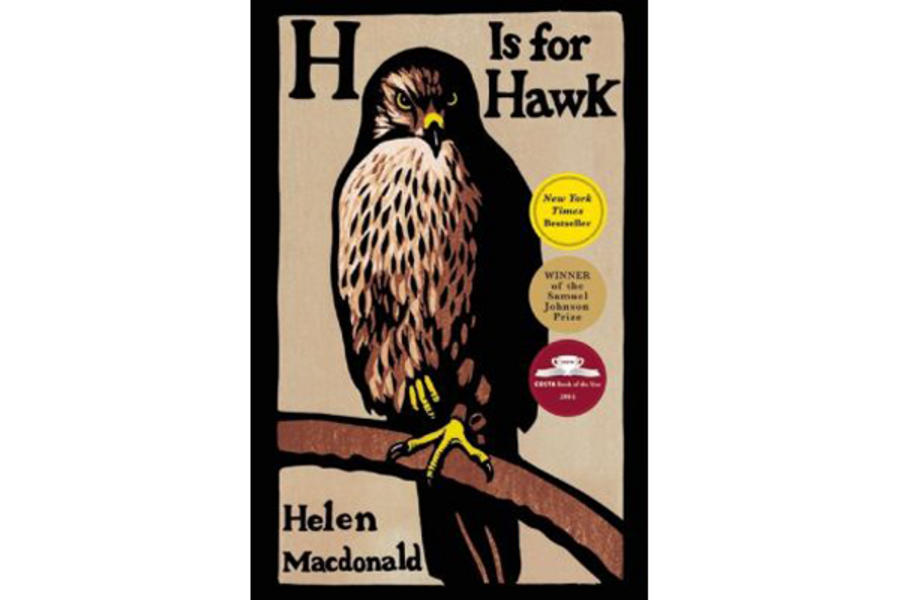'H is for Hawk' celebrates the healing power of the wild
Loading...
When Helen Macdonald lost her beloved father to a heart attack, she found herself quite suddenly alone. Alisdair Macdonald had been a noted photographer, the kind who also made up weekend jaunts like getting a shot of every bridge that crosses the Thames. He had been wise and warm; a friend and companion to his daughter, a naturalist and poet and then-fellow at Cambridge University. That spring, just as her fellowship was ending, his death loosed a flood of grief in Macdonald. She fell in and out of love, watched the light outside her window grow watery. She felt “odd, overtired, overwrought, unpleasantly like my brain had been removed and my skull stuffed with something like microwaved aluminum foil.” In the grip of her sadness, Macdonald began to be pursued by an odd, persistent vision: of flying a goshawk.
The goshawk – which Macdonald calls “the birdwatcher’s dark grail” – is no ordinary bird: It is giant, bloody, and rare even among falconers, themselves already a rare breed. Then again, even among the rare, Macdonald is no ordinary falconer: she’s a young, urban woman and – unlike many in the sport – not from a particularly posh background. But she’s the sort of person who can be captured by an obsession, and she had been teaching herself and others about hawks since she was a kid. She had flown other hawks for years. She had been watching goshawks the month before her father died, and somehow their image resurfaced and began to haunt her.
Thus, even as Macdonald’s grief grows wild, in the year following the news, she latches onto something perhaps yet wilder – an enormous bird of prey. This decision sets in motion her remarkable memoir H Is for Hawk, which has already won some terrific British awards, including the Costa and the Samuel Johnson Prize for Nonfiction. By summer Macdonald enlists a friend to help her drive to Scotland and hand over £800 for a young taloned goshawk she plans to raise and take hunting. About this time Macdonald also starts rereading a formidable old classic, "The Goshawk," by T. H. White, whose Arthurian fantasy "The Sword and the Stone" also contains memorable falconing sequences. She shuns most other humans but engrosses herself in the story of White, a closeted homosexual sadist, who tries to tame his own inner hurt by hawking; and in her own new hawk, now named Mabel, whom she feeds bits of raw steak in her living room.
Macdonald’s own hurt makes her desperately want what Mabel brings her: a radical unsettlement from her own body; a temporary reprieve from human logic, and a sense that she can be invisible. The hawk – even in a cage, even in straps hawkers call jesses – transports her out of complicated 21st-century life and through literary time and toward an innerness whose shapes feel more manageable. “I was in the grip of very old and emotional ways of moving through landscape,” she writes, “experiencing forms of attention and deportment beyond conscious control.”
Yet her feelings are very human, too. As Macdonald raises the hawk, she teeters toward what many of us might recognize as depression. She takes better care of the hawk then she does of herself – the hawk has fresh air and fresh pheasant to eat, while Macdonald lets the bills pile up, chain-smokes, and eats frozen pizza. Yet in a curious way, the hawk, with its fierceness, also keeps Macdonald’s own ferocities at bay. Ruefully, looking back on the months she battled sorrow while preparing Mabel to hunt and kill, Macdonald reflects that perhaps “I was never truly mad. More mad north by northwest. I could tell a hawk from a handsaw always, but sometimes it was striking to me how similar they were.”
Yet if the hawk is like the handsaw, the hawk is also like grief – a thing not subject to human reason or rule. Nevertheless it is managing the hawk – in its very wildness – that brings Macdonald, slowly, through her own tempest. Paradoxically, it’s culture rather than nature that she finally does turn to. Somewhere toward the end of the year, Macdonald sees a therapist, and rather than losing herself to wilderness and invisibility makes use of a distinctly rationalist method – antidepressants help her find her way out of the fog. Little by little the book assembles itself. In the end the radical joy of being near something so untamable and essentially other paves a way for Macdonald to tame herself, to go on living. Macdonald leaves the mystery of this encounter open. After all, Macdonald discovers that in ways she has been wild like her goshawk, but she has also been wild like the reindeer lichen she pockets one day when she’s been hawk watching, the very reindeer moss she’d held when she learned her father was dead. “Keep reindeer moss in the dark, freeze it, dry it to a crisp, it won’t die. It goes dormant and waits for things to improve. Impressive stuff.”
Impressive stuff indeed. We might say the same about Macdonald’s own rich journey.








